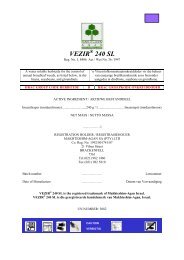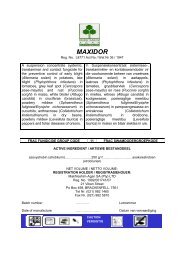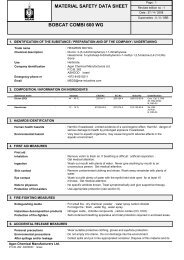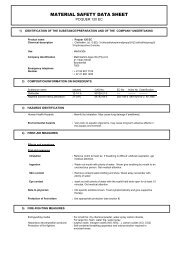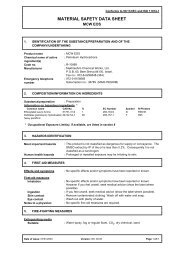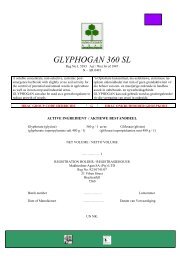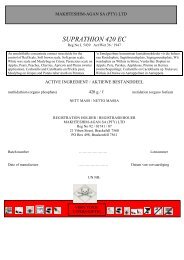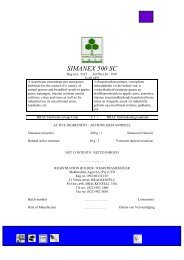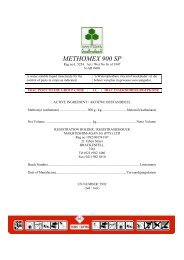acetogan ® plus 768 ec - Makhteshim-Agan SA (Pty) Ltd
acetogan ® plus 768 ec - Makhteshim-Agan SA (Pty) Ltd
acetogan ® plus 768 ec - Makhteshim-Agan SA (Pty) Ltd
Create successful ePaper yourself
Turn your PDF publications into a flip-book with our unique Google optimized e-Paper software.
ACETOGAN ® PLUS <strong>768</strong> EC<br />
Reg. No./Nr L 8557 Act No./Wet Nr. 36 of/van 1947<br />
N-AR 1116<br />
An emulsifiable concentrate herbicide with added<br />
safener applied pre-emergence on annual grasses<br />
and certain broadleaf weeds as listed below in<br />
groundnuts, maize, potatoes, sugar cane and<br />
sweetcorn.<br />
′n Emulsifiseerbare konsentraat onkruiddoder<br />
<strong>plus</strong> beveiliger wat eenjarige grasse en sekere<br />
breëblaaronkruide soos hieronder gelys,<br />
vooropkom beheer in aartappels, grondbone,<br />
mielies, suikermielies en suikerriet.<br />
HRAC HERBICIDE GROUP CODE K3 HRAC ONKRUIDDODERGROEPKODE<br />
ACTIVE INGREDIENT / AKTIEWE BESTANDDEEL<br />
Acetochlor (chloroacetamide)........................... <strong>768</strong> g/l......................... Asetochloor (chloorasetamied)<br />
Dichlormid (safener)......................................... 138 g/l...................................Dichlormied (beveiliger)<br />
NET VOLUME / NETTO VOLUME<br />
……………….<br />
REGISTRATION HOLDER / REGISTRASIEHOUER<br />
<strong>Makhteshim</strong>-<strong>Agan</strong> S.A. (<strong>Pty</strong>) <strong>Ltd</strong><br />
Co. Reg. No. / Mpy. Reg. Nr. 1992/001741/07<br />
21 Viben Street<br />
Brackenfell<br />
7560<br />
Tel: (021) 982 1460<br />
Fax: (021) 982 5810<br />
e-mail:info@masa.com<br />
Batch number........................................................................................................................ Lotnommer<br />
Date of manufacture...............................................................................................Vervaardigingsdatum<br />
UN No: 3082<br />
Class III<br />
Blue Band<br />
ACETOGAN ® PLUS <strong>768</strong> EC is the registered trademark of <strong>Makhteshim</strong>-<strong>Agan</strong> Israel.<br />
ACETOGAN ® PLUS <strong>768</strong> EC is die geregistreerde handelsmerk van <strong>Makhteshim</strong>-<strong>Agan</strong>, Israel.
WARNINGS<br />
• Handle with care.<br />
• Harmful if swallowed.<br />
• May be irritating to eyes, lungs and skin.<br />
• Toxic to fish and other aquatic organisms.<br />
• Store in a cool, dry and well-ventilated place away from dir<strong>ec</strong>t sunlight.<br />
• Keep in the original container, tightly closed and under lock and key.<br />
• Store away from food, feedstuffs, seed, and fertilizers.<br />
• Keep out of reach of children, uninformed persons and animals.<br />
• Re-entry: Do not enter treated area until spray deposit has completely dried unless wearing<br />
prot<strong>ec</strong>tive clothing.<br />
• Aerial application: Notify all inhabitants in the immediate area to be sprayed and issue the<br />
n<strong>ec</strong>essary warnings. Do not spray over or allow drift to contaminate water or adjacent areas<br />
Although this remedy has been extensively tested under a large variety of conditions, the<br />
registration holder does not guarantee that it will be eff<strong>ec</strong>tive under all conditions. The activity<br />
and eff<strong>ec</strong>t thereof may be aff<strong>ec</strong>ted by factors such as abnormal soil, climatic and storage<br />
conditions, quality of dilution water, compatibility with other substances not indicated on the<br />
label and the occurrence of resistance of the weeds against the remedy as well as by the method,<br />
time and accuracy of application. The registration holder furthermore does not accept<br />
responsibility for damage to crops, vegetation, the environment or harm to man or animal or<br />
for lack of performance of the remedy concerned due to failure by the user to follow the label<br />
instructions, or to the occurrence of conditions which could not have been foreseen in terms of<br />
the registration. Consult the supplier in the event of any uncertainty.<br />
PRECAUTIONS<br />
• Avoid inhaling the spray mist.<br />
• Avoid contact with skin and eyes.<br />
• Wear a face shield, rubber boots, and rubber gloves when handling the undiluted product.<br />
• Remove contaminated clothing and wash daily.<br />
• Wash immediately with soap and cold water after accidental skin contact.<br />
• In case of eye contact, hold eyelid open and wash out with clean running water for at least 15<br />
minutes.<br />
• Do not eat, drink or smoke while mixing or applying this product or before hands and face have<br />
been washed.<br />
• Prevent spray drift onto other crops, grazing, rivers, dams or areas not under treatment.<br />
• Invert the empty container over the spray or mixing tank and allow to drain for at least 30 s<strong>ec</strong>onds<br />
after the flow has slowed down to a drip. Rinse the container three times with a volume of water<br />
equal to a minimum of 10 % of that of the container. Add the rinsings to the spray tank.<br />
• Destroy empty container by perforation and flattening and NEVER use for any other purpose.<br />
• Clean the applicator thoroughly after use and dispose of wash water where it will not contaminate<br />
crops, rivers or dams.<br />
• Avoid contamination of food, feedstuffs, drinking water and eating utensils.<br />
1
RESISTANCE WARNING<br />
For resistance management ACETOGAN ® PLUS <strong>768</strong> EC is classified as a group code K3 herbicide.<br />
Any weed population may contain individuals naturally resistant to ACETOGAN ® PLUS <strong>768</strong> EC<br />
and other group code K3 herbicides. The resistant individuals can eventually dominate the weed<br />
population if these herbicides are used repeatedly. These resistant weeds may not be controlled by<br />
ACETOGAN ® PLUS <strong>768</strong> EC or any group code K3 herbicides. To delay herbicide resistance:<br />
• Avoid exclusive repeated use of herbicides from the same herbicide group code. Alternate or tank<br />
mix with products from different group codes<br />
• Integrate control methods (chemical, cultural and biological) into weed control programs.<br />
For sp<strong>ec</strong>ific information contact the local distributor agent or the registration holder of this product.<br />
Should ACETOGAN ® PLUS <strong>768</strong> EC fail to control resistant weeds, <strong>Makhteshim</strong>-<strong>Agan</strong> will not<br />
accept responsibility for such loss as the det<strong>ec</strong>tion of resistant weeds before application is difficult.<br />
Avoid using ACETOGAN ® PLUS <strong>768</strong> EC in places were weed resistance has been ascertained.<br />
USE RESTRICTIONS<br />
• Do not use ACETOGAN ® PLUS <strong>768</strong> EC on experimental or newly released seed hybrids, or<br />
inbred parent lines without first consulting with your seed supplier or the registration holder.<br />
• Do not use ACETOGAN ® PLUS <strong>768</strong> EC on poorly drained soils or soils with a compaction<br />
layer since this may lead to water logging which can result in crop injury.<br />
• When ACETOGAN ® PLUS <strong>768</strong> EC is tank mixed with other chemicals, the restrictions and<br />
warnings on the labels of the other chemicals must be adhered to.<br />
DIRECTIONS FOR USE: use only as dir<strong>ec</strong>ted<br />
Compatibility<br />
No cases of incompatibility with other agricultural chemicals have been reported. If a tank mix is to<br />
be made with other chemicals, first mix small quantities of the chemicals in water and then add to the<br />
tank while stirring. Ch<strong>ec</strong>k for any signs of incompatibility e.g. separation, flocculation, etc. When<br />
using in combination with other pesticides, read all the labels concerned and adhere to all the<br />
r<strong>ec</strong>ommendations.<br />
Mixing instructions<br />
• Shake the container well before use. Half fill the spray tank with clean water. Pre-mix the<br />
required volume of ACETOGAN ® PLUS <strong>768</strong> EC separately in a small amount of water and<br />
add to the spray tank while agitating. Fill the spray tank with water to the corr<strong>ec</strong>t volume.<br />
Ensure thorough agitation during mixing and application.<br />
• When tank mixing ACETOGAN ® PLUS <strong>768</strong> EC with other products such as SUPREX 900<br />
WG, SUPRANEX ® 900 WG, SUPRANEX ® 600 SC, ATRANEX ® 500 SC, ATRANEX ®<br />
90 WG , and DIUREX ® 800 SC, these products should first be mixed or creamed with a little<br />
water and added to the spray tank first. Add water to the tank just below the required capacity<br />
and add the pre-mixed ACETOGAN ® PLUS <strong>768</strong> EC while agitating continuously. Fill the<br />
tank with water. Refer to the labels of the products which will be tank mixed with<br />
ACETOGAN ® PLUS <strong>768</strong> EC and adhere to the label instructions.<br />
• Mix only sufficient spray mixture to be used on the same day. Do not allow the spray<br />
mixture to stand overnight.<br />
2
Ground application<br />
ACETOGAN ® PLUS <strong>768</strong> EC can be applied by means of any suitable medium to high volume spray<br />
apparatus provided it is equipped with an efficient agitating m<strong>ec</strong>hanism, it is corr<strong>ec</strong>tly calibrated and<br />
it is able to distribute the spray mixture evenly over the target area. Flat fan nozzles that can deliver a<br />
minimum of 200 l spray mixture per h<strong>ec</strong>tare are r<strong>ec</strong>ommended.<br />
ACETOGAN ® PLUS <strong>768</strong> EC should ideally be applied just after but not later than 5 days after<br />
planting, before weed emergence. The seedbed must be fine, firm, even and without any weed growth<br />
or an excessive amount of plant rests. Continuous rain or irrigation of at least 15 mm is needed after<br />
application to leach the herbicide into the soil. If it does not rain and weeds start to germinate, a<br />
shallow surface-blending cultivation should be done to control the weeds and to incorporate the<br />
product into the top 10−20 mm of soil.<br />
Aerial application<br />
Aerial application of ACETOGAN ® PLUS <strong>768</strong> EC (maize only) may only be done by a registered<br />
Aerial Application Operator using a corr<strong>ec</strong>tly calibrated, registered aircraft according to the<br />
instructions of <strong>SA</strong>NS 10118 (Aerial Application of Agricultural Pesticides). Ensure that the spray<br />
mixture is distributed evenly over the target area and that the loss of spray material during application<br />
is restricted to a minimum. It is therefore essential that the following criteria be met:<br />
• Volume: A spray mixture volume of 30 l per h<strong>ec</strong>tare is r<strong>ec</strong>ommended for pre-emergence and 30<br />
to 35 l per h<strong>ec</strong>tare for post-emergence applications. As this product has not been evaluated at a<br />
reduced volume rate, the registration holder cannot guarantee efficacy, or be held responsible for<br />
any adverse eff<strong>ec</strong>ts if this product is applied aerially at a lower volume rate than r<strong>ec</strong>ommended<br />
above.<br />
• Droplet coverage: 20 to 30 droplets per cm² must be r<strong>ec</strong>overed pre-emergence and 30 to 45<br />
droplet per cm 2 must be r<strong>ec</strong>overed post-emergence at the target area.<br />
• Droplet size: A droplet sp<strong>ec</strong>trum with a VMD of 350 to 400 microns is r<strong>ec</strong>ommended when<br />
applied pre-emergence and 300 to 350 microns when applied post-emergence. Limit the<br />
production of fine droplets less than 150 microns (high drift and evaporation potential) to a<br />
minimum.<br />
• Flying height: Maintain the height of the spray boom at 3 to 4 metres above the target. Do not<br />
spray when aircraft dives, is in a climb or when banking.<br />
• Use suitable atomising equipment that will produce the desired droplet size and coverage, but<br />
which will ensure the minimum loss of product. The spraying system must produce a droplet<br />
sp<strong>ec</strong>trum with the lowest possible Relative Span.<br />
• Position all the atomisers within the inner 60 to 75 % of the wingspan to prevent droplets from<br />
entering the wingtip vortices.<br />
• The difference in temperature between the wet and dry bulb thermometers, of a whirling<br />
hygrometer, should not exceed 8 °C.<br />
• Stop spraying if the wind speed exceeds 15 km/h.<br />
• Stop spraying under turbulent, unstable and dry conditions during the heat of the day.<br />
• Spraying under temperature inversion conditions (spraying in or above the inversion layer) and/or<br />
high humidity conditions (relative humidity 80 % and above) may lead to the following:<br />
a) reduced efficacy due to suspension and evaporation of small droplets in the air (inadequate<br />
coverage).<br />
b) damage to other sensitive crops and/or non-target areas through drifting of the suspended<br />
spray cloud away from the target field.<br />
• Ensure that the Aerial Spray Operator knows exactly which fields to spray.<br />
• Obtain an assurance from the Aerial Spray Operator that above requirements will be met and that<br />
the relevant data will be compiled in a log book for future reference.<br />
3
APPLICATION RATES<br />
1) Groundnuts<br />
Clay (%) Dosage (l/ha) Remarks<br />
0−10<br />
11−30<br />
0,9−1,8<br />
1,2−3,6<br />
Apply as a pre-emergence application on a weed-free<br />
seedbed. Use the higher rate for extended control of grasses<br />
and better control of broadleaf weeds and yellow nutsedge.<br />
2) Maize and sweetcorn<br />
Clay (%) Dosage (l/ha) Remarks<br />
0−10<br />
11−15<br />
16−20<br />
21−30<br />
31−40<br />
41−55<br />
0.64−1.60<br />
0.82−1.90<br />
1.00−1.90<br />
1.30−2.20<br />
1.60−2.50<br />
2.50<br />
Use the lower dosage rate if a short period of<br />
weed control is required between an application<br />
and cultivation and/or a follow-up application.<br />
The higher rates must be used in cases of high<br />
grass pressure and/or the suppression of yellow<br />
nutsedge.<br />
Note<br />
Low temperatures and/or heavy prolonged rains soon after planting may cause herbicide damage to<br />
the crops in the form of reduced germination, stunting, etc. These symptoms can also be aggravated if<br />
seed is planted too deep. Seed smaller than 4 flat has a higher risk of damage.<br />
3) Maize (tank mixture applications)<br />
3.1) Broadleaf weeds and grasses will be controlled and yellow nutsedge (Cyperus esculentus) will<br />
be conditionally controlled with tank mixtures of ACETOGAN ® PLUS <strong>768</strong> EC <strong>plus</strong><br />
ATRANEX ® 500 SC or ATRANEX ® 90 WG. Please refer to the relevant labels for full<br />
particulars and lists of weeds controlled.<br />
Clay (%)<br />
Dosage<br />
0−10<br />
11−15<br />
16−20<br />
21−30<br />
31−40<br />
41−55<br />
ACETOGAN ® PLUS <strong>768</strong> EC<br />
(l/ha)<br />
0.64−1.60<br />
0.82−1.90<br />
1.00−1.90<br />
1.30−2.20<br />
1.60−2.50<br />
2.50<br />
<strong>plus</strong> ATRANEX ® 500 SC<br />
(l/ha)<br />
2.50<br />
3.25<br />
3.25<br />
4.00<br />
4.75<br />
5.00<br />
or ATRANEX ® 90<br />
WG (kg/ha)<br />
1.4<br />
1.8<br />
1.8<br />
2.2<br />
2.6<br />
2.8<br />
4
3.2) Northern and western Free State and North West Province only. Broadleaf weeds and<br />
grasses will be controlled with a tank mixture of ACETOGAN ® PLUS <strong>768</strong> EC <strong>plus</strong><br />
ATRANEX ® 500 SC or ATRANEX ® 90 WG.<br />
Clay (%)<br />
0−10<br />
11−15<br />
16−20<br />
21−30<br />
ACETOGAN ®<br />
PLUS <strong>768</strong> EC<br />
(l/ha)<br />
0.64<br />
0.82<br />
1.00<br />
1.30<br />
Dosage<br />
<strong>plus</strong><br />
ATRANEX ®<br />
500 SC (l/ha)<br />
2.25<br />
2.25<br />
2.50<br />
2.75<br />
or<br />
ATRANEX ®<br />
90 WG (kg/ha)<br />
1.3<br />
1.3<br />
1.1<br />
1.5<br />
Remarks<br />
Yellow nutsedge control may not<br />
be satisfactory. Thorn apple<br />
sp<strong>ec</strong>ies and khaki weed may not be<br />
controlled season long.<br />
3.3) Wider sp<strong>ec</strong>trum of broadleaf weed control. ACETOGAN ® PLUS <strong>768</strong> EC and<br />
SUPRANEX ® 600 SC, SUPRANEX ® 900 WG, or SUPREX 900 WG in a tank mixture can<br />
be used in cases where a wider sp<strong>ec</strong>trum of broadleaf weed control is desired. Please refer to<br />
the relevant labels for full particulars and lists of the weeds controlled.<br />
Clay<br />
(%)<br />
0−10<br />
11−15<br />
16−20<br />
21−30<br />
31−40<br />
41−55<br />
ACETOGAN ® PLUS <strong>768</strong> EC<br />
(l/ha)<br />
0.64−1.60<br />
0.82−1.90<br />
1.00−1.90<br />
1.30−2.20<br />
1.60−2.50<br />
2.50<br />
Dosage<br />
<strong>plus</strong> SUPRANEX ® 600 SC<br />
(l/ha)<br />
2.0<br />
2.7<br />
2.7<br />
3.3<br />
4.0<br />
4.0<br />
or SUPRANEX ® 900 WG<br />
or<br />
SUPREX 900 WG<br />
(kg/ha)<br />
1.3<br />
1.8<br />
1.8<br />
2.2<br />
2.7<br />
2.7<br />
Note<br />
• If conditional yellow nutsedge control is desired, use the higher application rate of ACETOGAN<br />
PLUS ® <strong>768</strong> EC. For conditions, refer to the note following the list of weeds with variable control<br />
below.<br />
• The higher application rate of ACETOGAN ® PLUS <strong>768</strong> EC can also be used under conditions<br />
of high grass pressure (esp<strong>ec</strong>ially crab finger grass) in regions with high rainfall.<br />
• In some cases it is the preferred practice to incorporate a thiocarbamate herbicide before planting<br />
and apply tank mixtures post-emergence to the crop.<br />
• The above-mentioned tank mixtures of ACETOGAN ® PLUS <strong>768</strong> EC may be used in this way<br />
provided that the ACETOGAN ® PLUS <strong>768</strong> EC is only sprayed pre-emergence to the weeds as it<br />
possesses no post-emergence herbicidal activity.<br />
• Such applications should not be made later than the 5-leaf stage as the leaves of the maize crop<br />
may prevent the spray mixture from reaching the soil.<br />
• Please refer to the ATRANEX ® 500 SC, ATRANEX ® 90 WG, SUPRANEX ® 600 SC,<br />
SUPRANEX ® 900 WG, and SUPREX 900 WG labels for full particulars and lists of the weeds<br />
controlled.<br />
5
4) Sugarcane<br />
Clay (%) Dosage (l/ha) Remarks<br />
1−35<br />
>35<br />
2.5<br />
3.7<br />
ACETOGAN ® PLUS <strong>768</strong> EC should be tank mixed with<br />
the following broadleaf herbicides:<br />
DIUREX ® 800 SC: use 3 l/ha pre-emergence.<br />
ATRANEX ® 500 SC: use 2−3 l/ha pre-emergence only.<br />
Use the lower rate on soils with up to 35 % clay and the<br />
higher rate on heavier soils.<br />
5) Potatoes<br />
Clay (%) Dosage (l/ha) Remarks<br />
0−10<br />
0.82<br />
Apply under irrigation only. Crop injury may be<br />
11−20<br />
1.70<br />
caused by cold conditions following an<br />
21−30<br />
> 30<br />
1.90<br />
3.60<br />
ACETOGAN ® PLUS <strong>768</strong> EC application.<br />
WEEDS NORMALLY CONTROLLED<br />
Refer to the list of weeds below. The control of yellow nutsedge (Cyperus esculentus) as well as<br />
some broadleaf weeds may be variable and depends on whether climatic conditions are favourable or<br />
not. To increase the sp<strong>ec</strong>trum of broadleaf weeds controlled, it is r<strong>ec</strong>ommended that tank mixes or<br />
follow-on applications of other registered broadleaf herbicides are done in combination with<br />
ACETOGAN ® PLUS <strong>768</strong> EC.<br />
Annual grasses<br />
Chloris virgata<br />
Digitaria sanguinalis<br />
Eleusine coracana<br />
Panicum schinzii<br />
Setaria verticillata<br />
Urochloa panicoides<br />
Annual broadleaf weeds<br />
Amaranthus hybridus<br />
Amaranthus spinosus<br />
Chenopodium album<br />
Commelina benghalensis<br />
Galingsoga parviflora<br />
Physalis angulata<br />
Portulaca oleracea<br />
Schkuhria pinnata<br />
Tagetes minuta<br />
feathertop Chloris<br />
crab finger grass<br />
goose grass<br />
sweet buffalo grass<br />
sticky bristle grass<br />
herringbone grass<br />
Cape pigweed<br />
thorny pigweed<br />
white goosefoot<br />
Bengal wandering Jew<br />
gallant soldier<br />
Wild gooseberry<br />
purslane<br />
Dwarf marigold<br />
khaki weed (early germination)<br />
6
Control of the following weeds are variable<br />
Cyperus esculentus<br />
yellow nutsedge<br />
Cleome monophylla<br />
spindlepod<br />
Note<br />
Cyperus esculentus control can only be achieved when planting is done into a fine, firm, even seedbed<br />
immediately following a deep mouldboard ploughing. Planting must be done straight after the<br />
seedbed preparation. Continuous rain or irrigation of at least 15 mm on lighter soils and 25 mm on<br />
heavier soils should take place after application and before the nutsedge starts to germinate and<br />
develop.<br />
ATRANEX ® 500 SC (Reg. no. L5352) is the registered trade mark of <strong>Makhteshim</strong>-<strong>Agan</strong> Industries,<br />
Israel.<br />
ATRANEX ® 90 WG (Reg. no. L8138) is the registered trade mark of <strong>Makhteshim</strong>-<strong>Agan</strong> Industries,<br />
Israel.<br />
DIUREX ® 800 SC (Reg. no. L5334) is the registered trade mark of <strong>Makhteshim</strong>-<strong>Agan</strong> Industries, Israel.<br />
SUPRANEX ® 600 SC (Reg. No. L5351) is the registered trade mark of <strong>Makhteshim</strong>-<strong>Agan</strong> Industries,<br />
Israel.<br />
SUPRANEX ® 900 WG (Reg. No. L8172) is the registered trade mark of <strong>Makhteshim</strong>-<strong>Agan</strong> Industries,<br />
Israel.<br />
7
WAARSKUWINGS<br />
• Hanteer versigtig.<br />
• Skadelik indien ingesluk.<br />
• Mag oë, longe en vel irriteer.<br />
• Giftig vir visse en ander waterorganismes.<br />
• Stoor in ′n koel, droë en goed geventileerde plek weg van direkte sonlig.<br />
• Bêre in die oorspronklike houer, dig toe en agter slot en grendel.<br />
• Stoor weg van voedsel, voer, saad, en kunsmis.<br />
• Hou buite bereik van kinders, oningeligte persone en diere.<br />
• Herbetreding: Moet nie behandelde gebied binnegaan totdat die spuitneerslag droog is nie, tensy<br />
beskermende klere gedra word.<br />
• Lugtoediening: Stel al die inwoners in die onmiddellike omgewing van die gebied wat bespuit<br />
gaan word in kennis en reik die nodige waarskuwings uit. Moet nie oor aangrensende gebiede of<br />
water spuit of die spuitnewel toelaat om dit te besoedel nie.<br />
Alhoewel hierdie middel omvattend onder ′n groot verskeidenheid toestande getoets is,<br />
waarborg die registrasiehouer nie dat dit onder alle toestande doeltreffend sal wees nie. Die<br />
werking en doeltreffendheid daarvan kan beïnvloed word deur faktore soos abnormale grond,<br />
klimaats- en bergingstoestande, kwaliteit van die verdunningswater, verenigbaarheid met ander<br />
stowwe wat nie op die etiket aangedui word nie en die voorkoms van weerstand van die<br />
onkruide teen die betrokke middel sowel as die tyd en akkuraatheid van toediening. Verder<br />
aanvaar die registrasiehouer nie verantwoordelikheid vir skade aan gewasse, plantegroei en die<br />
omgewing of nadelige invloede op mens of dier of vir ′n gebrek aan prestasie van die betrokke<br />
middel as gevolg van versuim van die gebruiker om etiketaanwysings na te kom, of as gevolg<br />
van die ontstaan van toestande wat nie kragtens die registrasie voorsien kon word nie.<br />
Raadpleeg die verskaffer in die geval van enige onsekerheid.<br />
VOORSORGMAATREËLS<br />
• Vermy inaseming van die spuitnewel.<br />
• Vermy kontak met die vel en oë.<br />
• Dra ′n gesigskerm, rubberskoene en rubberhandskoene wanneer die onverdunde produk hanteer<br />
word.<br />
• Trek besoedelde klere uit en was daagliks.<br />
• Was onmiddellik met seep en koue water na per abuise velkontak.<br />
• In geval van oogkontak, spoel die oë dadelik uit met skoon lopende water vir ten minste 15<br />
minute.<br />
• Moet nie eet, drink of rook gedurende vermenging of toediening of voordat hande en gesig gewas<br />
is nie.<br />
• Vermy dat die spuitnewel oor ander gewasse, weiding, riviere, damme of gebiede wat nie onder<br />
behandeling is nie, wegdryf.<br />
• Keer die leë houer om oor die spuit of mengtenk en laat dreineer vir minstens 30 sekondes nadat<br />
die vloei tot ′n gedrup verander het. Spoel daarna die leë houer drie keer uit met ′n volume water<br />
wat minstens gelykstaande is aan 10 % van die volume van die houer. Voeg die spoelwater in die<br />
spuittenk.<br />
• Vernietig die leë houer deur dit te perforeer en plat te druk en moet dit NOOIT vir geen ander<br />
doel gebruik nie<br />
• Maak die toediener deeglik skoon na gebruik en gooi die spoelwater waar dit nie gewasse, riviere<br />
of damme sal besoedel nie.<br />
• Vermy besoedeling van voedsel, voer, drinkwater en eetgerei.<br />
7
WEERSTANDSWAARSKUWING<br />
Vir die bestuur van weerstand word ACETOGAN ® PLUS <strong>768</strong> EC as ′n groepkode K3 onkruiddoder<br />
geklassifiseer. Enige onkruidpopulasie mag individue hê wat natuurlike weerstand teen<br />
ACETOGAN ® PLUS <strong>768</strong> EC en groepkode K3 onkruiddoders besit. Die weerstandbiedende<br />
individue kan uiteindelik die populasie oorheers as hierdie onkruiddoders herhaaldelik gebruik word.<br />
Hierdie weerstandbiedende onkruide mag dalk nie deur ACETOGAN ® PLUS <strong>768</strong> EC of ander<br />
groepkode K3 onkruiddoders beheer word nie. Om onkruidweerstand te vertraag, kan die volgende<br />
gedoen word:<br />
• Vermy die herhaaldelike eksklusiewe gebruik van onkruiddoders van dieselfde<br />
onkruiddodergroepkode. Wissel af of gebruik tenkmengsels met produkte van ander<br />
onkruiddodergroepkodes.<br />
• Integreer beheermetodes (chemiese, verbouing en biologies) in onkruidbeheerprogramme<br />
Skakel u plaaslike verspreider of die registrasiehouer vir meer spesifieke inligting.<br />
Indien ACETOGAN ® PLUS <strong>768</strong> EC weerstandbiedende onkruide nie beheer nie, sal <strong>Makhteshim</strong>-<br />
<strong>Agan</strong> nie verantwoordelikheid vir sulke verliese aanvaar nie, aangesien die opspoor van<br />
weerstandbiedende onkruide voor toediening baie moeilik is. Vermy die gebruik van ACETOGAN ®<br />
PLUS <strong>768</strong> EC in gebiede waar onkruidweerstandbiedendheid reeds bevestig is.<br />
GEBRUIKSBEPERKINGS<br />
• Moet nie ACETOGAN ® PLUS <strong>768</strong> EC op eksperimentele, nuutvrygestelde kultivars of<br />
ingeteelde ouerplante gebruik voordat u eers die saadverskaffer of die registrasiehouer van die<br />
onkruiddoder geraadpleeg het nie.<br />
• Indien ACETOGAN ® PLUS <strong>768</strong> EC op swak gedreineerde gronde of gronde met ’n<br />
verdigtingslaag wat tot versuiptoestande kan lei, gebruik word, mag dit tot gewasskade lei.<br />
• Wanneer ACETOGAN ® PLUS <strong>768</strong> EC in ′n tenkmengsel met ander produkte gebruik word,<br />
moet die voorwaardes en beperkings soos wat op daardie etikette verskyn, nagekom word.<br />
GEBRUIK<strong>SA</strong>ANWYSINGS: gebruik slegs soos aangedui.<br />
Verenigbaarheid<br />
Geen gevalle van onverenigbaarheid met ander landbouchemikalieë is tot dusver aangemeld nie.<br />
Indien ′n tenkmengsel met ander landbouchemiese middels gemaak word, word aanbeveel dat eers<br />
klein hoeveelhede van elke middel apart aangemaak word in ′n klein hoeveelheid water en bymekaar<br />
gevoeg word terwyl geroer word. Evalueer vir enige teken van onverenigbaarheid soos bv skeiding,<br />
flokkulering ens. As in kombinasie met ander middels gebruik word moet die etiketvoorskrifte van<br />
die betrokke middels nagekom word.<br />
Vermenging<br />
• Skud die houer goed voor gebruik. Vul die spuittenk halfvol met skoon water. Meng die<br />
benodigde hoeveelheid ACETOGAN ® PLUS <strong>768</strong> EC vooraf apart met water en voeg in die<br />
tenk terwyl geroer word. Vul die tenk met water tot die verlangde volume terwyl voortdurend<br />
geroer word.<br />
• Wanneer tenkmengsels met ACETOGAN ® PLUS <strong>768</strong> EC en ander produkte soos<br />
SUPREX 900 WG, SUPRANEX ® 900 WG, SUPRANEX ® 600 SC, ATRANEX ®<br />
500 SC, ATRANEX ® 90 WG en DIUREX ® 800 SC gemaak word, moet hierdie<br />
produkte gemeng of verroom word met ′n klein hoeveelheid water en eerste in die<br />
spuittenk gevoeg word. Voeg nou water by tot net onder die verlangde kapasiteit en<br />
8
voeg nou die vooraf gemengde ACETOGAN ® PLUS <strong>768</strong> EC by terwyl voortdurend<br />
geroer word. Vul nou die spuittenk met water. Verwys na die etikette van die<br />
produkte wat met ACETOGAN ® PLUS <strong>768</strong> EC gemeng gaan word en kom die<br />
etiketvoorskrifte na.<br />
• Verseker deeglike roering tydens vermenging en toediening. Meng net genoeg spuitmengsel<br />
vir ′n dag se gebruik. Moet nie die spuitmengsel oornag laat staan nie.<br />
Grondtoediening<br />
ACETOGAN ® PLUS <strong>768</strong> EC kan deur middel van enige geskikte medium- of hoëvolume<br />
spuitapparaat toegedien word, mits dit toegerus is met ’n doeltreffende roermeganisme, dit korrek<br />
gekalibreer is en in staat is om die spuitmengsel eweredig oor die teikengebied te versprei.<br />
Platwaaierspuitpunte wat ten minste 200 l water per hektaar kan lewer word aanbeveel.<br />
ACETOGAN ® PLUS <strong>768</strong> EC moet verkieslik net na, maar nie later as 5 dae na plant voor onkruide<br />
ontkiem, toegedien word op ′n fyn, ferm en gelyk saadbed sonder oormatige plantreste. Aanhoudende<br />
reën of besproeiing van ten minste 15 mm is nodig na toediening om die aktiewe bestanddeel in die<br />
grond in te loog tot in die onkruidontkiemingssone. As dit nie reën nie en die onkruid ontkiem, kan ′n<br />
vlak bewerking uitgevoer word om die onkruide te beheer en die onkruiddoder in die boonste 10−20<br />
mm grond in te werk.<br />
Lugtoediening<br />
ACETOGAN ® PLUS <strong>768</strong> EC(slegs mielies) kan slegs deur ′n geregistreerde Lugbespuitingsperateur<br />
met ′n korrek gekalibreerde, geregistreerde vliegtuig volgens die instruksies van <strong>SA</strong>NS 10118 (Aerial<br />
Application of Agricultural Pesticides) uit die lug bespuit word. Verseker dat die spuitmengsel<br />
eweredig oor die teikenarea versprei word, en die verlies aan spuitmengsel tydens toediening tot ′n<br />
minimum beperk word. Dit is daarom belangrik om aan die volgende vereistes te voldoen:<br />
• Volume: ′n Spuitmengsel volume van 30 l per ha vooropkom en 30 tot 35 l per ha naopkom<br />
word aanbeveel. Hierdie produk is nie teen ′n verlaagde volume getoets nie. Die<br />
registrasiehouer kan nie effektiteit waarborg, of verantwoordelik gehou word vir enige nadelige<br />
effekte indien hierdie produk teen ‘n laer volume, as hierbo aanbeveel, toegedien word nie.<br />
• Druppel bedekking: 20 tot 30 druppels per cm² moet op die teikenarea herwin word vir<br />
vooropkoms en 35 tot 45 druppels per cm² vir na-opkoms.<br />
• Druppelgrootte: ′n Druppelspektrum met ′n VMD van 300 tot 400 mikrons word aanbeveel vir<br />
toediening vooropkoms en 300 tot 350 mikrons vir toediening na-opkoms. Beperk die produksie<br />
van druppels kleiner as 150 mikrons (hoë drywing en verdampingspotensiaal) tot ′n minimum.<br />
• Vlieghoogte: Handhaaf die hoogte van die spuitbalk bo die teiken op 3 tot 4 meter. Moet nie<br />
spuit wanneer die vliegtuig duik nie, uitklim of draai nie.<br />
• Gebruik geskikte atomiseringsapparaat wat die vereiste druppelgrootte en bedekking sal<br />
produseer, maar die minste verlies van produk verseker. Die spuitstelsel moet ′n druppelspektrum<br />
met die kleinste moontlike Relatiewe Span produseer.<br />
• Plaas al die atomiseerders in die binnste 60 tot 75 % van die vlerkspan om te verhoed dat druppels<br />
binne-in die vlerkpuntvorteks beweeg.<br />
• Die verskil in temperatuur tussen die nat- en droëboltermometer van ′n swaaihigrometer, moet nie<br />
8 °C oorskry nie.<br />
• Stop bespuiting indien die windspoed 15 km/uur oorskry.<br />
• Stop bespuiting tydens turbulente, onstabiele en droë toestande gedurende die hitte van die dag.<br />
• Bespuiting onder temperatuur inversie toestande (deur bo of binne die inversie laag te spuit) en/of<br />
hoë lugvog toestande (relatiewe humiditeit 80 % en meer) mag tot volgende probleme aanleiding<br />
gee:<br />
a) verlaagde effektiwiteit aangesien die druppels as ′n wolk in die lug bly hang en moontlik<br />
verdamp (onvoldoende bedekking op teiken).<br />
b) skade aan nie-teiken gewasse of sensitiewe areas as gevolg van wegdrywing van die<br />
spuitwolk na nie-teiken area.<br />
• Verseker dat die Lugbespuitingsoperateur presies weet watter lande bespuit moet word.<br />
9
• Dit is noodsaaklik om ′n versekering van die Lugbespuitingsoperateur te verkry dat aan al die<br />
bogenoemde vereistes voldoen sal word en dat data van belang in ′n logboek saamgevat is vir<br />
toekomstige verwysing.<br />
TOEDIENINGSHOEVEELHEDE<br />
1) Mielies en suikermielies<br />
Klei % Dosis (l/ha) OPMERKINGS<br />
0−10<br />
11−15<br />
16−20<br />
21−30<br />
31−40<br />
41−55<br />
0.64−1.60<br />
0.82−1.90<br />
1.00−1.90<br />
1.30−2.20<br />
1.60−2.50<br />
2.50<br />
Gebruik lae toedieningshoeveelheid waar ′n kort<br />
periode van onkruidbeheer benodig word tussen<br />
toediening en ′n skoffelbewerking en/of ′n<br />
opvolgbespuiting. In gevalle van hoë-grasdruk<br />
en/of geeluintjie-onderdrukking moet die hoër<br />
toedieningshoeveelhede gebruik word.<br />
Nota<br />
Die temperatuur en/of swaar aanhoudende reën direk na plant kan onkruiddoderskade soos swak<br />
ontkieming, groeivertraging, ens. van die gewas tot gevolg hê. Hierdie simptome kan vererger<br />
wanneer saad te diep geplant word. Saad keiner as 4 plat het ′n hoër risiko vir beskadiging.<br />
2) Mielies (tenkmengsel toedienings)<br />
2.1) Breëblaaronkruide en grasse sal beheer word en geeluintjies (Cyperus esculentus)<br />
voorwaardelik beheer word met tenkmengsels van ACETOGAN ® PLUS <strong>768</strong> EC,<br />
ATRANEX ® 500 SC of ATRANEX ® 90 WG. Raadpleeg die toepaslike etikette vir volledige<br />
besonderhede en lyste van onkruide wat beheer word.<br />
Klei (%)<br />
0−10<br />
11−15<br />
16−20<br />
21−30<br />
31−40<br />
41−55<br />
ACETOGAN ® PLUS <strong>768</strong> EC<br />
(l/ha)<br />
0.64−1.60<br />
0.82−1.90<br />
1.00−1.90<br />
1.30−2.20<br />
1.60−2.50<br />
2.50<br />
Dosis<br />
<strong>plus</strong> ATRANEX ® 500 SC<br />
(l/ha)<br />
2.50<br />
3.25<br />
3.25<br />
4.00<br />
4.75<br />
5.00<br />
1.4<br />
1.8<br />
1.8<br />
2.2<br />
2.6<br />
2.8<br />
of ATRANEX ® 90<br />
WG (kg/ha)<br />
2.2) Slegs noord- en wes-Vrystaat en Noordwes Provinsie. Breëblaaronkruide en gras sal beheer<br />
word met ′n tenkmengsel van ACETOGAN ® PLUS <strong>768</strong> EC, <strong>plus</strong> ATRANEX ® 500 SC of<br />
ATRANEX ® 90 WG.<br />
Klei (%)<br />
0−10<br />
11−15<br />
16−20<br />
21−30<br />
ACETOGAN ®<br />
PLUS <strong>768</strong> EC<br />
(l/ha)<br />
0.64<br />
0.82<br />
1.00<br />
1.30<br />
Dosis (l/ha)<br />
<strong>plus</strong><br />
ATRANEX ®<br />
500 SC<br />
(l/ha)<br />
2.25<br />
2.25<br />
2.50<br />
2.75<br />
of<br />
ATRANEX ®<br />
90 WG<br />
(kg/ha)<br />
1.3<br />
1.3<br />
1.1<br />
1.5<br />
Opmerkings<br />
Geeluintjie beheer sal nie<br />
bevredigend wees nie. Olieboom en<br />
kakiebos mag moontlik nie die hele<br />
seisoen beheer word nie.<br />
10
2.3) Wyer spektrum van breёblaar onkruidbeheer. ACETOGAN ® PLUS <strong>768</strong> EC en<br />
SUPRANEX ® 600 SC, <strong>plus</strong> SUPRANEX ® 900 WG, of SUPREX 900 WG in ′n tenkmengsel<br />
kan in gevalle gebruik word waar ′n wyer spektrum van breёblaar onkruidbeheer verlang word.<br />
Raadpleeg die toepaslike etikette vir volledige besonderhede en lyste van onkruide wat beheer<br />
word.<br />
Klei<br />
(%)<br />
0− 10<br />
11− 15<br />
16−20<br />
21−30<br />
31−40<br />
41−55<br />
ACETOGAN ® PLUS <strong>768</strong> EC<br />
(l/ha)<br />
0.64−1.60<br />
0.82−1.90<br />
1.00−1.90<br />
1.30−2.20<br />
1.60−2.50<br />
2.50<br />
Dosis<br />
<strong>plus</strong> SUPRANEX ® 600 SC<br />
(l/ ha)<br />
2.0<br />
2.7<br />
2.7<br />
3.3<br />
4.0<br />
4.0<br />
of SUPRANEX ® 900 WG<br />
of<br />
SUPREX 900 WG<br />
(kg/ha)<br />
1.3<br />
1.8<br />
1.8<br />
2.2<br />
2.7<br />
2.7<br />
Nota<br />
• Gebruik die hoër toedieningshoeveelheid van ACETOGAN ® PLUS <strong>768</strong> EC indien<br />
voorwaardelike geeluintjiebeheer verlang word. Verwys na die nota wat volg op die lys hieronder<br />
van onkruide wat wisselvallig beheer word, vir voorwaardes.<br />
• Die hoër toedieningshoeveelheid van ACETOGAN ® PLUS <strong>768</strong> EC kan ook gebruik word onder<br />
toestande van baie hoë grasdruk (veral van kruisvingergras) in gebiede met hoë reënval.<br />
• In sommige gevalle is die praktyk om voor plant eers ′n tiokarbamaat in die grond in te werk en<br />
daarna, na-opkom van die gewas, op te volg met tenkmengsels.<br />
• Bogenoemde tenkmengsels van ACETOGAN ® PLUS <strong>768</strong> EC kan in sulke gevalle toegedien<br />
word, maar daar moet deeglik op gelet word dat ACETOGAN ® PLUS <strong>768</strong> EC slegs<br />
vooropkomsaktiwiteit het, en beslis nie onkruid na-opkom sal beheer nie.<br />
• Daar word aanbeveel om nie later as die 5-blaarstadium van die mielies te spuit nie aangesien die<br />
blare van die gewas dan te veel van die spuitmengesel van die grond kan afskerm.<br />
• Raadpleeg die ATRANEX ® 500 SC, ATRANEX ® 90 WG, SUPRANEX ® 600 SC,<br />
SUPRANEX ® 900 WG en SUPREX 900 WG etikette vir volledige besonderhede en lyste van<br />
onkruide wat beheer word.<br />
3) Suikerriet<br />
Klei (%) Dosis (l/ha) Opmerkings<br />
1−35<br />
2.5<br />
ACETOGAN ® PLUS <strong>768</strong> EC kan met die volgende<br />
>35<br />
3.7<br />
breëblaaronkruiddoders in ′n tenkmengsel toegedien word:<br />
DIUREX ® 800 SC: gebruik 3 l / ha vooropkoms.<br />
ATRANEX ® 500 SC: gebruik slegs 2−3 l/ha vooropkoms.<br />
Gebruik die laer dosis vir gronde tot en met 35 % klei en die<br />
hoër dosis op swaarder gronde.<br />
11
4) Aartappels<br />
Klei (%) Dosis (l/ha) Opmerkings<br />
0−10<br />
11−20<br />
21−30<br />
> 30<br />
0.82<br />
1.70<br />
1.90<br />
3.60<br />
Dien slegs onder besproeiing toe. Koue toestande<br />
na ′n ACETOGAN ® PLUS <strong>768</strong> EC toediening<br />
mag gewasskade tot gevolg hê.<br />
5) Grondbone<br />
Klei (%) Dosis (l/ha) Opmerkings<br />
0−10<br />
11−30<br />
0,9−1,8<br />
1,2−3,6<br />
Dien vooropkom op ’n onkruidvrye saadbed toe. Gebruik die hoër dosis<br />
vir langer beheer van grasse en beter beheer van breëblaaronkruide en<br />
geeluintjies.<br />
ONKRUIDE NORMAALWEG BEHEER<br />
Verwys na die onkruidlys hieronder. Die beheer van geeluintjies (Cyperus esculentus) asook sekere<br />
breëblaaronkruide mag wisselvallig wees en is hoofsaaklik afhanklik van weerstoestande. Om die<br />
beheerspektrum van breëblaaronkruide te verbeter, word aanbeveel dat ACETOGAN ® PLUS <strong>768</strong><br />
EC in tenkmengsels met geregistreerde breёblaarmiddels toediening word, of dat die ACETOGAN ®<br />
PLUS <strong>768</strong> EC toediening opgevolg moet word met ′n toediening van ′n geregistreerde<br />
breёblaaronkruiddoder.<br />
Eenjarige Grasse<br />
Chloris virgata<br />
Digitaria sanguinalis<br />
Eleusine coracana<br />
Panicum schinzii<br />
Setaria verticillata<br />
Urochloa panicoides<br />
Eenjarige Breëblaaronkruide<br />
Amaranthus hybridus<br />
Amaranthus spinosus<br />
Chenopodium album<br />
Commelina benghalensis<br />
Galingsoga parviflora<br />
Physalis angulata<br />
Portulaca oleracea<br />
Schkuhria pinnata<br />
Tagetes minuta<br />
witpluimchloris<br />
kruisvingergras<br />
jongosgras<br />
soetbuffelsgras<br />
klitsborselgras<br />
beesgras<br />
Gewone misbredie<br />
doringmisbredie<br />
withondebossie<br />
Bengaalse wandelende Jood<br />
knopkruid<br />
wilde-appelliefie<br />
porslein<br />
kleinkakiebos<br />
kakiebos (vroeg ontkiemend)<br />
Beheer van die volgende onkruide is wisselvallig<br />
Cyperus esculentus<br />
geeluintjie<br />
Cleome monophylla<br />
rusperbossie<br />
NOTA:<br />
Om Cyperus esculentus te beheer moet die plantproses voorafgegaan word deur ’n diep<br />
ploegbewerking. Die plantproses moet onmiddellik na die saadbed voorbereiding geskied. Die<br />
12
saadbed moet fyn, ferm, eweredig en sonder oormatige plantreste wees. Aanhoudende reën of<br />
besproeiing van tussen 15 mm vir ligter en 25 mm vir swaarder gronde moet plaasvind na toediening<br />
en voor die uintjies ontkiem en begin ontwikkel.<br />
ATRANEX ® 500 SC (Reg. no. L5352) is die geregistreerde handelsmerk van <strong>Makhteshim</strong>-<strong>Agan</strong><br />
Industries, Israel.<br />
ATRANEX ® 90 WG (Reg. no. L8138) is die geregistreerde handelsmerk van <strong>Makhteshim</strong>-<strong>Agan</strong><br />
Industries, Israel.<br />
DIUREX ® 800 SC (Reg. no. L5334) is die geregistreerde handelsmerk van <strong>Makhteshim</strong>-<strong>Agan</strong> Industries,<br />
Israel.<br />
SUPRANEX ® 600 SC (Reg. No. L5351) is die geregistreerde handelsmerk van <strong>Makhteshim</strong>-<strong>Agan</strong><br />
Industries, Israel.<br />
SUPRANEX ® 900 WG (Reg. No. L8172) is die geregistreerde handelsmerk van <strong>Makhteshim</strong>-<strong>Agan</strong><br />
Industries, Israel.<br />
13



